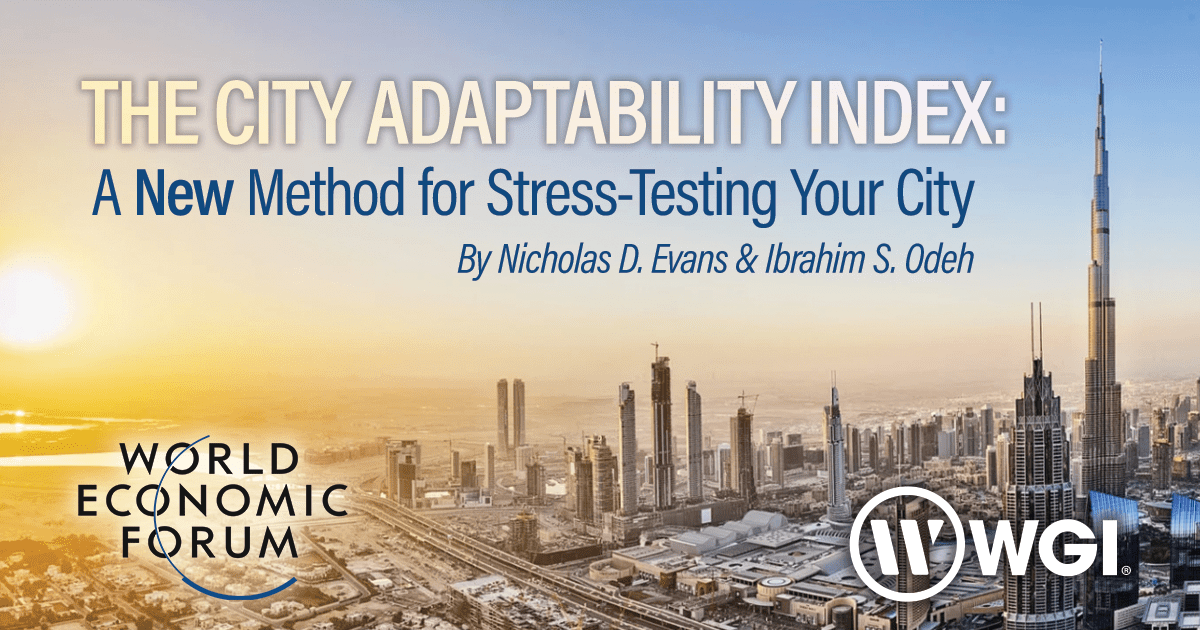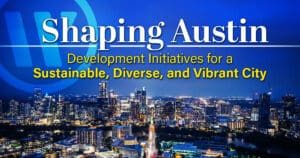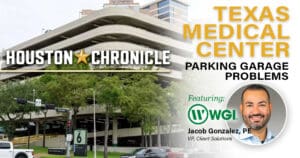
WGI Unleashed Episode 89: Lyndsey Duty, Environmental Scientist
On the latest episode of the WGI Unleashed podcast, we sit down with Lyndsey Duty, one of WGI’s Environmental Scientists based out of our Tampa, FL office!
Learn from award-winning professionals — explore our whitepapers, blogs, and the latest industry updates.
Join our dynamic organization of engineers, land surveyors, landscape architects, environmental scientists, and architects!
Talk to a market leader today! We’ll answer any questions you have about our professional services.

By: Nicholas D. Evans – Chief Innovation Officer, WGI Inc. and Ibrahim S. Odeh – Founding director, Global Leaders in Construction Management, Columbia University
In an earlier article, 3 steps to build smart adaptive cities of the future, we discussed the concept of “The Adaptive City” and how this new strategic management approach to dealing with change and disruption can help cities around the world continuously maximize their performance across all strategic goals. With disruption moving from the exception to the norm, it’s now more important than ever for cities to not just be resilient and sustainable, but to become adaptive to meet ever-increasing challenges and opportunities in the years ahead.
Rather than reacting to change and disruption after the fact, it’s important for cities to build intrinsic agility into their everyday operating models and processes so they can sense and respond to continuous disruption in real-time. An Adaptive City is one that is able to respond to evolving or changing needs of the future with intrinsic agility across both physical and digital aspects of its operating model. An Adaptive City is not a consequence, but a choice.
By implementing digital and physical enablers of adaptability, to rapidly respond to change and disruption, or to seize new opportunities, the Adaptive City is able to continuously optimize the key performance indicators (KPIs) and metrics associated with each of its city strategic goals. It can therefore meet more of its goals, for more of its stakeholders, for more of the time.
To help cities self-assess their current level of adaptability and benchmark against their peers, WGI Inc., in conjunction with Columbia Universities’ Global Leaders in Construction Management (GLCM), has developed the City Adaptability Index.
The index is a maturity assessment tool designed to help cities assess and benchmark their intrinsic ability (i.e. their “built in” ability) to navigate continuous change and disruption, regardless of their size.
Comprised of eight pillars that correspond to universal city strategic goals of economic growth, sustainability and environment, health and wellness, diversity and inclusion, mobility, safety and security, quality of life, and efficiency and resilience, the self-assessment poses 24 questions (three per pillar) and rates cities around the world on a scale of 1 through 4 in terms of their adaptability maturity (see figure below).
Incorporating adaptability, or an intrinsic ability to change, can benefit cities as well as government and private sector organizations in terms of improved mission effectiveness, improved citizen service, increased operational efficiency, faster response times, the ability to do more with less and reduced costs.
It is also important to note that with the index, we are not measuring absolute progress in terms of sustainability or resilience, but more the ability to dynamically respond to changing conditions in order to maximize the key performance indicators (KPIs) – and often the “uptime” – associated with these city strategic goals.
As an example with the Health and Wellness pillar, we’re not measuring the number of hospitals within the city limits, or the quality of healthcare provided, but more the city’s ability to respond to change such as when New York City took advantage of the Javits Center and brought in the US Navy hospital ships for medical surge capacity during COVID-19.
Today, the City Adaptability Index has been taken by over 580 city officials and citizens to self-assess their cities. We have received self-assessments from over 53 counties and 155 cities.
As we might expect in these early days of incorporating adaptability into city operating models and processes, the global average for all pillars is between 2.0 and 2.5 (on a 1 to 4 scale) in terms of the current maturity level.
The highest rated pillars to date are health and wellness, and diversity and inclusion. We attribute this to the fact that the recent global pandemic was a forcing function that prompted cities to respond to this shock to the system and enhance their adaptability and responsiveness. Diversity and inclusion has also benefitted from global attention and the ability to be implemented quickly via policy change.
The lowest rated pillar, at present, is sustainability and environment. This clearly is a long-term strategic goal that is taking many years to implement due to the reliance on not just policy change, but physical and digital enablers, such as renewable energy infrastructure, circular economy infrastructure, AI, and internet of things, which need to be implemented and effectively engineered into the process.
Dubai in the United Arab Emirates was among the top 10 cities to date due to various city initiatives such as its smart police stations offering 27 services in six languages and other innovations that enable it to dynamically adapt and support the multi-faceted needs of its citizens. In the United States, Miami and San Diego were among the cities with the highest average ratings to date across all eight pillars.
Whether you’re a city official or a citizen, we welcome you to take the self-assessment for your city.
To access the original article, please click here.

Nicholas Evans is VP, Chief Innovation Officer at WGI where he supports the firm in the development and implementation of technology-enabled strategies for innovation, sustainability and growth, leveraging opportunities for digital transformation.
Prior to WGI, Mr. Evans was Research Vice President in Gartner’s Strategy and Innovation practice where we worked with global private and public-sector organizations to define and apply best practices in digital transformation, strategy and innovation.
Prior to joining Gartner, Mr. Evans was Global Head of Innovation and VP & GM, CTO Office at Unisys where he was responsible for the client-facing global innovation program, technology strategic initiatives, as well as leading the company’s strategy and thought leadership focus on digital transformation, disruptive technologies and trends. With more than 25 years of consulting experience, he previously ran the Global Emerging Technology Consulting practice at KPMG as well as serving as the National Technical Director for E-Business Consulting and System Integration at PwC. He co-founded the National Internet Consulting Practice for Coopers & Lybrand in the late-90s.
One of Consulting Magazine’s Top 25 Consultants, and one of ComputerWorld’s Premier 100 IT Leaders’, he is the author of over 10 books on business and technology strategy including titles from the British Computer Society, Financial Times Prentice Hall, Tech TV and Microsoft Press. He has shared his perspectives in leading publications as well as broadcast media such as CNBC Squawk Box, History Channel and Discovery Channel. His most recent book is the multi-award winning ‘Mastering Digital Business’ a strategic guide to the next wave of digital transformation.
He holds a B.Sc. (Hons) and M.Sc. from Southampton University in England. His extracurricular interests include triathlon having been a member of Team USA and former U.S. National Champion in his division.

On the latest episode of the WGI Unleashed podcast, we sit down with Lyndsey Duty, one of WGI’s Environmental Scientists based out of our Tampa, FL office!

WGI’s San Antonio team laced up their running shoes and braved the rain to take on the iconic Rock and Roll 5K – Discover how they turned challenges into triumphs in this memorable event recap!

With a legacy of supporting, empowering, & inspiring women in transportation, the WTS Central Florida’s Annual Awards & Scholarship Banquet was nothing short of a night to remember.

Discover how Austin is transforming urban development with proposed zoning changes, inclusive housing initiatives, and creative space preservation—all while embracing growth and sustainability.

Texas Medical Center made $78M from parking last year. Why haven’t its busiest garages been upgraded in years?

Discover how WGI helped bring Lively Lane to life—a vibrant community in San Marcos that blends sustainable design, live/work townhomes, and natural beauty to create the perfect balance of urban convenience and serenity.
You’ve been searching for a place like WGI. We look forward to meeting you soon.
Sign up to receive emails to hear our latest news and achievements in our monthly newsletter.
Enter your zip code, and we’ll personalize your experience with local projects, office locations, team members, and more.
WGI supports its associates with meaningful opportunities for growth, strong benefits and perks, while we work collaboratively with clients and co-consultants to shape and improve communities.






WGI is a dynamic organization with opportunities nationwide for engineers, land surveyors, landscape architects, environmental scientists, and architects.